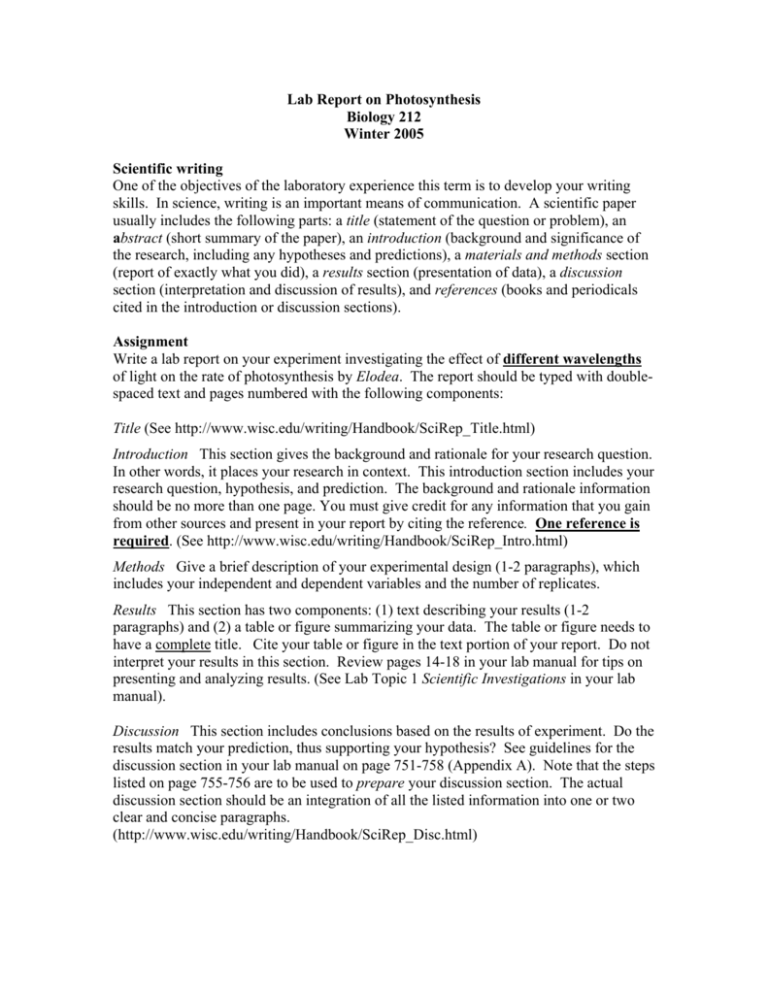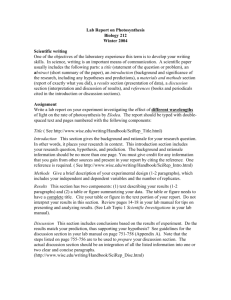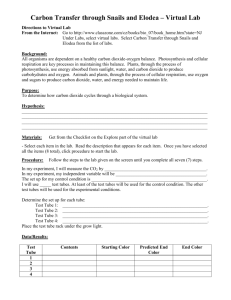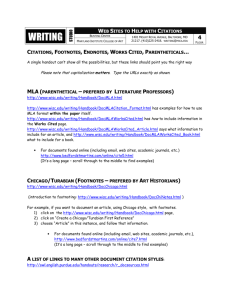Writing Assignment
advertisement

Lab Report on Photosynthesis Biology 212 Winter 2005 Scientific writing One of the objectives of the laboratory experience this term is to develop your writing skills. In science, writing is an important means of communication. A scientific paper usually includes the following parts: a title (statement of the question or problem), an abstract (short summary of the paper), an introduction (background and significance of the research, including any hypotheses and predictions), a materials and methods section (report of exactly what you did), a results section (presentation of data), a discussion section (interpretation and discussion of results), and references (books and periodicals cited in the introduction or discussion sections). Assignment Write a lab report on your experiment investigating the effect of different wavelengths of light on the rate of photosynthesis by Elodea. The report should be typed with doublespaced text and pages numbered with the following components: Title (See http://www.wisc.edu/writing/Handbook/SciRep_Title.html) Introduction This section gives the background and rationale for your research question. In other words, it places your research in context. This introduction section includes your research question, hypothesis, and prediction. The background and rationale information should be no more than one page. You must give credit for any information that you gain from other sources and present in your report by citing the reference. One reference is required. (See http://www.wisc.edu/writing/Handbook/SciRep_Intro.html) Methods Give a brief description of your experimental design (1-2 paragraphs), which includes your independent and dependent variables and the number of replicates. Results This section has two components: (1) text describing your results (1-2 paragraphs) and (2) a table or figure summarizing your data. The table or figure needs to have a complete title. Cite your table or figure in the text portion of your report. Do not interpret your results in this section. Review pages 14-18 in your lab manual for tips on presenting and analyzing results. (See Lab Topic 1 Scientific Investigations in your lab manual). Discussion This section includes conclusions based on the results of experiment. Do the results match your prediction, thus supporting your hypothesis? See guidelines for the discussion section in your lab manual on page 751-758 (Appendix A). Note that the steps listed on page 755-756 are to be used to prepare your discussion section. The actual discussion section should be an integration of all the listed information into one or two clear and concise paragraphs. (http://www.wisc.edu/writing/Handbook/SciRep_Disc.html) References You must give credit to any information that you gain from other sources and that you present in your report. At least one reference is required. See resources below for guidelines on citing references. References need to be listed in alphabetical order by author’s last name. No references from the Internet will be accepted for this assignment unless from an online peer reviewed scientific journal. • How to decide what information must be referenced http://www.wisc.edu/writing/Handbook/QPA_plagiarism.html • How to write a successful summary without plagiarizing http://www.wisc.edu/writing/Handbook/QuotingSources.html http://www.wisc.edu/writing/Handbook/QuotingSources.html • How to cite references http://www.wisc.edu/writing/Handbook/DocCBE_NameYear_Intext.html Additional Resources • The Biology web site, http://osu.orst.edu/instruct/bi212/writew05.htm, has information on resources for writing and library research. • General information on writing a scientific report Appendix A Scientific Writing in your lab manual. • Evaluation form included with this assignment sheet. • Be sure to talk with your Lab Instructor if you have any questions. Due Date Your Lab Instructor will assign the due date. The grade on late reports will decrease 5% per day. Evaluation Your lab report will be evaluated on the content (4 points) and the effectiveness of your communication, including text and figures (5 points). See the attached page for a sample evaluation form. Evaluation of Lab Report on Photosynthesis Biology 212 Winter 2005 CONTENT Title Introduction Background and rationale Research question Hypothesis Prediction Methods Description of experimental design Procedures Results Table or figure (graph) Text describing results Discussion References COMMUNICATION Writing Grammar, spelling, punctuation, capitalization Sentence construction Paragraph structure: sentences in logical order supporting one main idea in each paragraph Organization of paragraphs Conciseness and clarity of writing Table or figure Each title tells a complete story Organization of report Headings and subheadings included Double-space text Pages Numbered COMMENTS Lab Report on Photosynthesis Biology 212 Winter 2005 TAKE THIS PAGE HOME. Use the data to complete the writing assignment. Question: Hypothesis: Prediction: Procedures: 1. Assemble the manometer. Fill two test tubes completely with 1.5% sodium bicarbonate. Take a piece of Elodea, make a fresh cut at the cut end, and, holding the test tube over the sink or a pan, add the Elodea, stem end up, and the rubber stopper with the syringe and graduated pipette to each test tube. The stoppers should displace the water so that no air is inside the tubes. Cover one tube with aluminum foil. Cover the second tube with colored cellophane. 2. Set the assembled manometers into a test tube rack. 3. Place the heat sink immediately adjacent to the manometer. 4. Using the meter stick, measure and place a piece of tape on the lab bench adjacent to the heat sink 15 cm away from the heat sink. 5. Place the light source at the 15 cm mark. 6. Use the syringe in the stopper to set the starting point of the water at a mark on the graduated pipette close to each test tube, the experimental and the control. Record the initial pipette reading. 7. Turn on the light. Wait 15 minutes. Record the final pipette reading for each tube. 8. Using the syringe, readjust the starting pointing of the water to a mark close to each test tube, and record the initial reading. (You may not need to readjust the control tube). Results 1. Calculate the change in manometer reading for the control and experimental tubes by subtracting the final reading from the initial reading (I-F). Record your results. 2. Calculate the corrected volume of oxygen produced at by subtracting the change in the control tube (A) from the change in the experimental tube (B). Record your results. 3. Record the volume of oxygen produced as measured by other teams. Calculate the total and mean, or average, for the class data. 4. Plots the class data on the graph. Data: TABLE 6.7 Experiment Two: Volume of Oxygen Produced from Elodea Exposed to Different Wavelengths of Light (Investigative Exercise, Summary of class data) Corrected Volume of Oxygen Produced Replicate Green Red Blue All colors 1 2 3 Total: Mean: total/# teams







